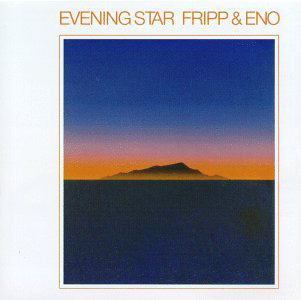
In the 1970s, prolific musician, composer, and producer Brian Eno helped to define the budding genre of ambient music. Throughout the decades, Eno has continued to deliver quality experimental music, amassing his impressive discography. Within that body of work, his collaboration with virtuosic guitarist, Robert Fripp, who led King Crimson, a group that would influence many progressive rock bands, including Yes, Genesis, and Rush, is often lost. Their initial collaborations in the 1970s, as well as their 2004 reunion, The Equatorial Stars, are absent from all major streaming services and are nearly inaccessible without the purchase of a CD or vinyl.
Despite the obstacles barring the masses from accessing Fripp and Eno’s collaborations, these albums are tremendous works of beauty and are well worth the extra effort. Their second collaborative album, Evening Star, released in 1975, is far from sophomoric, providing gorgeous, rich tones over intriguing, yet subtle musical themes. This album saw Fripp and Eno take a gentler, more refined approach compared to their first album, (No Pussyfooting), released two years prior to Evening Star. In Evening Star, Fripp and Eno mastered the technique first used in (No Pussyfooting) that would later be labeled “Frippertronics.” “Frippertronics” involves passing sound between two reel-to-reel tapes, adding layers as the reels are routed back and forth. Though they were not the first to develop a technique of this nature, Eno’s adaption of “Frippertronics” in his ambient compositions led to its popularization.
Evening Star’s first track, “Wind on Water” starts slowly, and builds as Eno’s synthesizers are piled on top of the comparatively faint, shimmering melodic tones. The song continues on in this fashion, with the title perfectly reflecting its sound. “Wind on Water” gives us about two minutes to cool off after its peak before blending seamlessly into the next tune. The second track provides the album its name, and for good reason. “Evening Star” is, in my opinion, the best and most beautiful of the five tracks on the album. Not quite as reliant on synths for its intrigue as “Wind on Water,” “Evening Star” builds its core themes on Eno’s piano and Fripp’s guitar. Providing ethereal vibes and a distinct sense of mystique and curiosity, “Evening Star” is an eight-minute masterpiece that leaves the listener feeling somewhat unsettled, and offers the album’s first true break before it continues into “Evensong.”
“Evensong” continues on the same other-worldly vein that Fripp and Eno carefully constructed in “Evening Star.” Short and sweet compared to the preceding track, “Evensong” is a perfect example of Fripp and Eno’s looping technique, as the song elaborates on an introductory riff, growing in complexity as the song reaches its conclusion. The next track, “Wind on Wind” is the only piece on the album that Robert Fripp and Brian Eno didn’t work on together. An excerpt from Eno’s solo album, Discreet Music, “Wind on Wind” is steeped in synthesizers, providing us with a relaxing and stunning reprieve before the nearly half-hour long “An Index Of Metals.” “An Index of Metals” deliberately puts listeners in a place of discomfort, making use of dissonance and distortion, a distinct transition from the transcendent beauty of the first half of the album. The song builds into a cacophonic smattering of noises and is undeniably masterful.
Evening Star is a truly wonderful collection of ambient music, and I can’t recommend it enough. I encourage you not to fall victim to the convenience of Spotify, and to put in the extra effort to listen to Fripp and Eno’s work of art.
